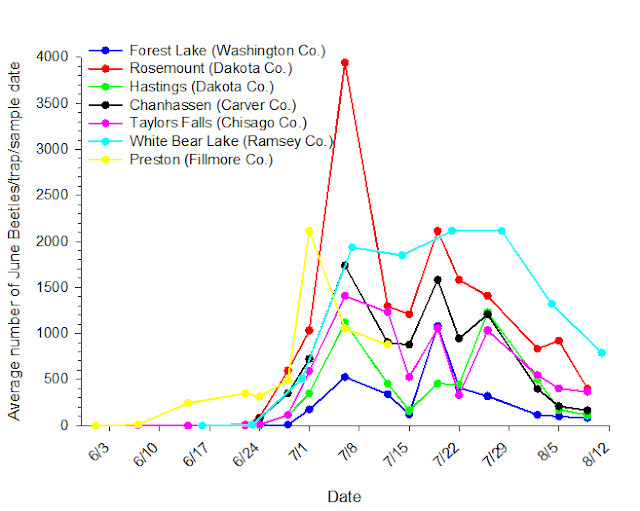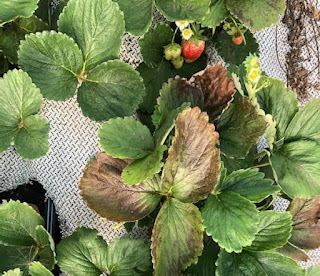 |
| MN55 (First Kiss) apples at harvest-time, late August, 2020. Annie Klodd. |
Author: Annie Klodd, Extension Educator - Fruit and Vegetable Production
In this week's fruit update:
- SWD and Japanese beetle trap counts
- Grape harvest
- Apple harvest
- Day-neutral strawberries
- Questions on these or other fruit crops? Call or email me at kloddann@umn.edu
Spotted Wing Drosophila and Japanese beetle counts
 |
| Above: Average SWD numbers caught in traps across the growing season, on 6 Minnesota farms. Source: UMN FruitEdge/SWD Trapping Network |
 |
| Average Japanese beetle numbers captured in pheromone traps across the growing season, on 7 Minnesota farms. Source: UMN FruitEdge/Japanese Beetle Trapping Network. |
Grapes
Birds: With harvest coming up quick and early, bird netting and/or audio deterrents should now be installed.
Birds tend to be more of a problem for vineyards during drought years like this. If there are fewer fruit-based food sources in their natural habitats due to drought, then it is logical that they rely more on vineyards and other cultivated fruits.
Comparing Bird Management Tactics for Vineyards and Berry Crops
Harvest-time insect pests:
- Follow pre-harvest intervals (PHI) on the insecticide labels; spray
early enough to accommodate your scheduled harvest dates while obeying PHIs.
- Wasps: I just wrote an article about controlling wasps in vineyards. Please read it here.
- Multi-colored Asian lady beetles (MALB): Even minuscule numbers of MALB can have drastic negative affects on wine quality. I recently heard of one vineyard that uses an un-loaded airblast sprayer to blow MALB out of grape clusters. However most vineyards resort to insecticides if they find the insects in the vineyard. More info here.
- Spotted wing drosophila (SWD): Fruit flies including SWD are the major vector of sour rot infection. Spraying for fruit flies has been shown to significantly reduce sour rot. Learn more here.
- Please use the Midwest Fruit Pest Management Guide - Grape Spray Program chapter to find which insecticides to use for each insect. This is the same resource that we as Extension Educators use when growers ask us what to spray. If you need clarification or recommendations on how to use it, please contact me.
Harvest-time diseases:
- Learn how to distinguish sour rot, botrytis bunch rot, powdery mildew and phomopsis. Do not include infected clusters in the harvest bins. Harvest-time diseases were covered in this recent UMN/UW Extension webinar.
Apples
Has anyone started harvesting First Kiss yet? I have heard rumors that First Kiss harvest will start next week! Hopefully most growers are using the starch-iodine test for ripeness before beginning - the timing of ripening will vary by orchard.
One grower (Alexandria area) shared a photo of his starch-iodine test results yesterday, showing that his First Kiss is close, but not ripe yet.
Spotting fruit issues: Harvest is a key time where growers may start noticing unidentified fruit blemishes and wondering what has caused them. Diagnosing problems is helpful for next year, because it helps us hone in our management practices and target the most significant pests.
Growers are always welcome (and encouraged!) to send Extension Educators like myself photos of "weird fruit." If I don't know the answer, I ask around to other fruit specialists in other states. Sometimes, we will suggest you submit samples to the UMN Plant Disease Clinic for diagnosis, if it can't be deciphered from a photo.
Silver leaf disease: Keep an eye out for silver leaf, which is a fungal disease of apple trees that gradually kills whole trees or sections of trees as it spreads through the trees' xylem and phloem. There are several sites in Minnesota with silver leaf, that I am aware of. We don't know how common it is in the state.
If silver leaf infects a whole tree rather than just a limb, the only way to manage it is to cut down the tree; therefore it does become an economic concern.
Silver leaf enters the xylem or phloem of the tree through wounds - pruning wounds, grafting wounds, and winter injury.
 |
| It is SO difficult to get a good photo of silver leaf that doesn't just look like a brightly-exposed image, but here is a good attempt by Lindsey Miller, summer Extension Assistant. |
The biggest clue that a tree or limb has silver leaf is a silvery discoloration on the leaves. Sometimes, the silver sheen is really subtle and more easily spotted by looking down the row and comparing the color against that of surrounding trees.
 |
| A close-up image of a silver leaf-infected limb, with characteristic silver/gray sheen on the leaves. Photo: Annie Klodd |
This is not to be confused with powdery mildew, which is more blotchy in appearance.
But it's not the leaves that are the real problem. The disease is inside the tree, gradually cutting off nutrient and water transport; we just see clues of it on the leaves because it causes them to look silver.
Since silver leaf is caused by a pathogen inside the tree, foliar fungicide applications are not effective on it. Read this article for more information on silver leaf. It would be helpful if you let me know if you suspect it, so that we can work together on a strategy to try to mitigate it.
Strawberries
 |
| Browning on mature day-neutral strawberry leaves. Grower-submitted photo. |
Day neutral strawberries sometimes exhibit browning on their most mature leaves late in the season. This is a normal symptom of the old leaves senescing and is not cause for concern. If younger leaves begin to show discoloration, or if the plants are exhibiting other symptoms like stunted growth or low yields, then there may be a foliar nutrient deficiency that requires diagnosis and amendment.
Comments
Post a Comment